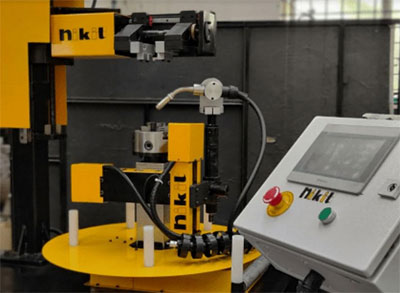Orbital Welding
Vishes Global is a key supplier, providing cutting-edge technology tailored for the stainless-steel industry. Our solutions address challenges related to cleaning, passivation, and corrosion across a spectrum of stainless-steel grades and high-performance alloys, encompassing Duplex and Titanium materials. With an extensive network of skilled suppliers and distributors, we prioritize the success of those who invest in our products.
Our commitment to innovation is reflected in our regular product updates, aimed at enhancing safety, reliability and efficiency. With a dedicated R&D team and substantial investment in research and development, we continuously refine our processes and achieve exceptional results.Orbital Welders:

An orbital welder is a specialized welding machine that is used for automated welding of pipes, tubes and other cylindrical components. It is designed to produce high quality, consistent welds with precision and accuracy. The orbital welding process involves rotating the welding torch around the work piece while simultaneously feeding the filler
material to create a continuous weld. This method ensures uniformity in the weld bead and minimizes the risk of defects such as porosity and lack of fusion. These devices are often equipped with advanced features such as computerized control systems, monitoring sensors and programmable welding parameters to optimize the welding process.
These tools are valued for their ability to produce reliable, high-quality welds efficiently, making them essential in many industries where precision welding is critical.
Advantages of Orbital Welders:
• Consistency: Since the welded head rotates around the work piece, it ensures
uniformity and consistency.
• Precision: These instruments can achieve precise welds, even on complex
geometries.
• High quality welds: The controlled welding parameters and consistent motion result
in high-quality welds with minimal defects.
• Productivity: This type of soldering can be automated, which increases productivity
and reduces labor costs.
• Cleanliness: In industries like pharmaceuticals or food processing, where hygiene is
crucial, orbital welding produces clean, smooth welds without contamination.
Features and Techniques of Orbital Welders:
• Uranami Weld Bead: This type of weld bead pattern is often desired for aesthetic
purposes or to enhance certain mechanical properties of the weld such as fatigue
resistance. Achieving a uranium weld bead pattern typically involves specific
welding techniques and parameters which can be implemented using this
equipment.
• AVC (Auto Voltage Controller): AVC or Auto Voltage Controller is a feature found in
some orbital welding systems. It is designed to maintain a consistent arc length by
automatically adjusting the voltage during welding. This feature is crucial for
ensuring consistent weld quality especially when dealing with variations in material
thickness.
• Weaving: Weaving technique refers to where the weld torch or electrode is
oscillated from side to side during the welding process. This motion creates a wider
weld bead and helps ensure proper fusion between the base metals. Weaving is
commonly used in orbital welding especially for welding thicker materials or when
additional weld reinforcement is required.
Orbital Welders Application industries:
• Aerospace: These devices and the welding process are widely used in aerospace
manufacturing for joining critical components such as aircraft tubing, engine parts
and fuel systems. The high precision and consistent weld quality provided are
crucial for ensuring the reliability and safety of aerospace structures.
• Pharmaceutical and Biotechnology: In industries where cleanliness and sterility are
paramount such as pharmaceutical and biotechnology manufacturing, this type of
bonding is used to create sanitary connections in piping systems. These joints must
meet stringent standards to prevent contamination and maintain product integrity.
• Food and Beverage: Similar to pharmaceuticals, the food and beverage industry
relies on this soldering process to create hygienic connections in processing
equipment and piping systems. These tools produce smooth welds that minimize
the risk of bacterial growth and contamination.
• Semiconductor Manufacturing: This type of fusion is employed in semiconductor
manufacturing for joining ultra-high purity gas delivery systems and vacuum
chambers. The precise control and cleanliness of such joints are critical in
maintaining the purity levels required for semiconductor fabrication processes.
• Nuclear Power: The process of this kind of merging is utilized in the construction
and maintenance of nuclear power plants for welding reactor components, piping
systems and pressure vessels. The high quality and reliability of this bonding is
essential for ensuring the safety and integrity of nuclear facilities.
• Oil and Gas: In the oil and gas industry, this sort of joining is used for fabricating
pipelines, process piping and offshore structures. These devices are particularly
useful in harsh environments where access to skilled welders may be limited, and
consistent weld quality is essential for preventing leakages.
• Automotive: The functioning of these welders is used in the automotive industry for
joining exhaust systems, fuel lines and other components requiring high strength,
leak free welds. The automation capabilities of the said equipment can help
improve productivity and reduce manufacturing costs in automotive assembly
plants.

